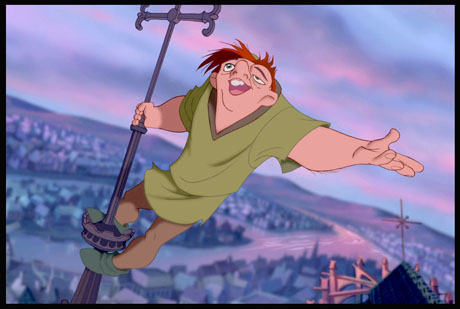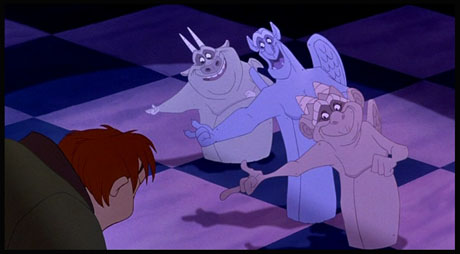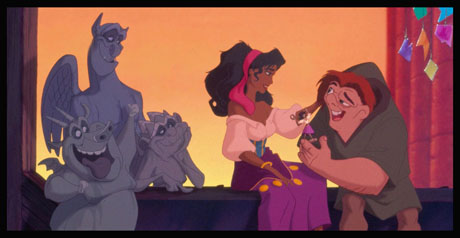
The Hunchback of Notre Dame, Victor Hugo’s brooding literary classic wouldn’t be most people’s first response to the question: “How will Disney follow-up The Lion King and Pocahontas?” So, why was it chosen? “What appealed to us was the characters of the piece and the opportunity to tell a story about a character who was an outcast,” said the film’s producer Don Hahn, in an interview in 1996, just before The Hunchback of Notre Dame was released to theaters.
Using the central messages of Hugo’s original work, Hahn, along with co-directors Kirk Wise and Gary Trousdale (the three had already collaborated on 1991’s landmark, Oscar-winning Beauty and the Beast), indeed found a way to fuse the novel with Disney animation.

The studio’s The Hunchback of Notre Dame remains a stunning, daring, and emotional Disney animated feature twenty-five summers after its debut.
The film is introduced and told to the audience by Clopin (voiced by Broadway veteran Paul Kandel), the energetic Gypsy, who unravels the tale of Quasimodo (Tom Hulce), the misunderstood and misshapen bellringer of Notre Dame cathedral. Quasimodo has been secluded in the tower by his repressive guardian, the evil Judge Claude Frollo (Tony Jay), who forbids Quasimodo ever to leave the cathedral’s tower. The hunchback’s only “escape” is through the conversations he has with his three imaginary friends, the Gargoyles Victor, Hugo, and Laverne (Charles Kimbrough, Jason Alexander, and Mary Wickes, respectively). They affectionately refer to him as “Quasi.”
Quasimodo yearns to be part of the outside world. One day, he finds the courage to join the “Feast of Fools,” a massive festival in the city below. While there, he encounters Esmerelda, the beautiful gypsy dancer (Demi Moore), and Phoebus, the Captain of the Guard (Kevin Kline). Despite his attempts to remain unnoticed, the crowd soon recognizes Quasi as the mysterious bellringer from Notre Dame and begins attacking him. Esmerelda comes to his rescue, and the two then take sanctuary inside the cathedral. Quasimodo is so taken with Esmerelda’s act of kindness that he helps her escape from Frollo, who soon becomes obsessed with finding her. It’s then up to Quasimodo, assisted by Phoebus, to help save Esmerelda from Frollo in a fantastic action sequence in and around Notre Dame in the film’s climax.

The Hunchback of Notre Dame fearlessly tackled the darker themes that were a part of Hugo’s original work. This is most notable in the song “Hellfire.”
In the sequence, filled with nightmarish, fiery images straight out of the “Night on Bald Mountain” sequence from Fantasia, Frollo sings of his conflicted yearning for Esmerelda.
A daring sequence and Disney villain. Hahn called Frollo “…a character of probably more complexity than we’ve ever done.”
Brought to the screen by animator Kathy Zielinski, who masterfully merges Tony Jay’s deep, powerful voice with a character performance, Frollo’s subtler moments are sometimes more potent than the villain’s grander sequences.
It’s one of many examples of brilliant performances in Hunchback. Among them, animator James Baxter takes cues from Tom Hulce’s emotional performance to craft the most empathetic Quasimodo the screen has ever seen. And, Paul Kandel and animator Michael Surrey come together to make Clopin a most fascinating, enigmatic character.
The Hunchback of Notre Dame also took a tremendous technological leap to bring to life Schwartz and Menken’s showstopper, “Topsy Turvy,” performed during the festival sequence. Kiran Joshi supervised a team of computer animators to create the crowd of revelers and blizzard of confetti for the dazzling “Topsy Turvy” sequence. The CGI meshes seamlessly with the hand-drawn images in the scene, creating a true tour-de-force of animation. Computers also created 6,000 townspeople and soldiers for the film’s climax.
“Topsy Turvey” also features most unique and creative lyrics (“Scurvy knaves are extra scurvy on the 6th of Jan-u-urvy”) and in addition to “Hellfire,” is one of the many compelling numbers created for the film by lyricist Stephen Schwartz and composer Alan Menken.

Hunchback, produced when Disney animation merged heavily with the Broadway musical, slipped the songs seamlessly in and out of dialogue. The songs are ingrained in the story, helping the plot progress. This is especially true in the film’s opening prologue number, “The Bells of Notre Dame,” where the audience learns about the events that brought Quasimodo to his life in the bell tower.
The pre-title opening sequence is still a “grab you by the lapels” stunner. Created by directing animators (and brothers) Paul and Gaetan Brizzi at Disney’s Paris studio, the scene is filled with some of Disney’s most exquisite animation. The audience is pulled immediately into the film, in which a tremendous amount of backstory is conveyed quickly, dramatically, and emotionally.
The Hunchback of Notre Dame also adds a lighter tenor through the story with the characters of the gargoyles. With “Quasi” being the only character who can see them, in a Calvin and Hobbes-esque way, it connects the story to an element of fantasy that Disney animation does so well, without detracting from the proceedings.
When The Hunchback of Notre Dame opened on June 21, 1996, audiences’ response to the film was lukewarm and critical reaction was all over the map. Entertainment Weekly’s Owen Gleiberman awarded the film an “A” and praised it as a “Towering Achievement.” At the same time, Janet Maslin in The New York Times had a more negative reaction, writing: “There’s just no way to delight children with a feel-good version of this story.”
However, since the film premiered, appreciation continues to grow for The Hunchback of Notre Dame. The film’s story, artistry, and messages all took chances to expand animation during the studio’s prolific renaissance period.
Critic Matthew Lucas of the website “From the Front Row” sums up today’s perspective looking back at Hunchback. He wrote: “It is a great paradox, a film denied commercial success, because of its darker themes, but a film that succeeds artistically for those very reasons.”
Twenty-five years later, it’s also the still-timely messages in Disney’s The Hunchback of Notre Dame that allow the film to endure. Don Hahn said that Hugo’s classic tells us, “Don’t discard the outcasts in life or people because they’re different, because there is great worth in those people.”
- An Eye for A Classic: The 60th Anniversary of “Mr. Magoo’s Christmas Carol” - December 22, 2022
- A Very Merry Mickey: The 70th Anniversary of “Pluto’s Christmas Tree” - December 19, 2022
- A Fine French Feline Film: The 60th Anniversary of “Gay Pur-ee” - December 12, 2022


 June 25th, 2021
June 25th, 2021  Michael Lyons
Michael Lyons  Posted in
Posted in  Tags:
Tags: 






